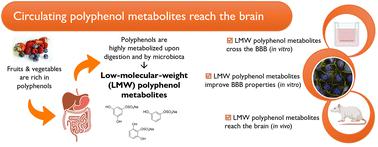当前位置:
X-MOL 学术
›
Food Funct.
›
论文详情
Our official English website, www.x-mol.net, welcomes your
feedback! (Note: you will need to create a separate account there.)
Circulating low-molecular-weight (poly)phenol metabolites in the brain: unveiling in vitro and in vivo blood–brain barrier transport
Food & Function ( IF 5.1 ) Pub Date : 2024-07-05 , DOI: 10.1039/d4fo01396d Rafael Carecho 1, 2 , Daniela Marques 1 , Diogo Carregosa 1 , Domenico Masuero 3 , Mar Garcia-Aloy 3 , Federica Tramer 4 , Sabina Passamonti 4 , Urska Vrhovsek 3 , M Rita Ventura 2 , Maria Alexandra Brito 5, 6 , Cláudia Nunes Dos Santos 1, 2, 7 , Inês Figueira 1
Food & Function ( IF 5.1 ) Pub Date : 2024-07-05 , DOI: 10.1039/d4fo01396d Rafael Carecho 1, 2 , Daniela Marques 1 , Diogo Carregosa 1 , Domenico Masuero 3 , Mar Garcia-Aloy 3 , Federica Tramer 4 , Sabina Passamonti 4 , Urska Vrhovsek 3 , M Rita Ventura 2 , Maria Alexandra Brito 5, 6 , Cláudia Nunes Dos Santos 1, 2, 7 , Inês Figueira 1
Affiliation

|
Circulating metabolites resulting from colonic metabolism of dietary (poly)phenols are highly abundant in the bloodstream, though still marginally explored, particularly concerning their brain accessibility. Our goal is to disclose (poly)phenol metabolites’ blood–brain barrier (BBB) transport, in vivo and in vitro, as well as their role at BBB level. For three selected metabolites, benzene-1,2-diol-3-sulfate/benzene-1,3-diol-2-sulfate (pyrogallol-sulfate – Pyr-sulf), benzene-1,3-diol-6-sulfate (phloroglucinol-sulfate – Phlo-sulf), and phenol-3-sulfate (resorcinol-sulfate – Res-sulf), BBB transport was assessed in human brain microvascular endothelial cells (HBMEC). Their potential in modulating in vitro BBB properties at circulating concentrations was also studied. Metabolites’ fate towards the brain, liver, kidney, urine, and blood was disclosed in Wistar rats upon injection. Transport kinetics in HBMEC highlighted different BBB permeability rates, where Pyr-sulf emerged as the most in vitro BBB permeable metabolite. Pyr-sulf was also the most potent regarding BBB properties improvement, namely increased beta(β)-catenin membrane expression and reduction of zonula occludens-1 membrane gaps. Whereas no differences were observed for transferrin, increased expression of caveolin-1 upon Pyr-sulf and Res-sulf treatments was found. Pyr-sulf was also capable of modulating gene and protein expression of some solute carrier transporters. Notably, each of the injected metabolites exhibited a unique tissue distribution in vivo, with the remarkable ability to almost immediately reach the brain.
中文翻译:

大脑中循环的低分子量(多)酚代谢物:揭示体外和体内血脑屏障转运
膳食(多)酚的结肠代谢产生的循环代谢物在血液中含量很高,但仍很少被探索,特别是在它们的大脑可及性方面。我们的目标是揭示(多)酚代谢物在体内和体外的血脑屏障(BBB)转运,以及它们在 BBB 水平上的作用。对于三种选定的代谢物,苯-1,2-二醇-3-硫酸盐/苯-1,3-二醇-2-硫酸盐(连苯三酚-硫酸盐 - 吡咯-硫)、苯-1,3-二醇-6-硫酸盐(间苯三酚硫酸盐 – Phlo-sulfate)和苯酚-3-硫酸盐(间苯二酚硫酸盐 – Res-sulfate),在人脑微血管内皮细胞(HBMEC)中评估了 BBB 转运。还研究了它们在循环浓度下调节体外BBB 特性的潜力。在 Wistar 大鼠注射后,代谢物在大脑、肝脏、肾脏、尿液和血液中的命运被揭示。 HBMEC 的转运动力学突出了不同的 BBB 渗透率,其中 Pyr-sulf 成为体外BBB 渗透性最强的代谢物。 Pyr-sulf 在改善 BBB 特性方面也是最有效的,即增加 β(β)-catenin 膜表达和减少 zonula occlusionns-1 膜间隙。虽然转铁蛋白没有观察到差异,但发现 Pyr-sulf 和 Res-sulf 处理后 Caveolin-1 的表达增加。 Pyr-sulf 还能够调节一些溶质载体转运蛋白的基因和蛋白质表达。值得注意的是,每种注射的代谢物在体内都表现出独特的组织分布,具有几乎立即到达大脑的卓越能力。
更新日期:2024-07-06
中文翻译:

大脑中循环的低分子量(多)酚代谢物:揭示体外和体内血脑屏障转运
膳食(多)酚的结肠代谢产生的循环代谢物在血液中含量很高,但仍很少被探索,特别是在它们的大脑可及性方面。我们的目标是揭示(多)酚代谢物在体内和体外的血脑屏障(BBB)转运,以及它们在 BBB 水平上的作用。对于三种选定的代谢物,苯-1,2-二醇-3-硫酸盐/苯-1,3-二醇-2-硫酸盐(连苯三酚-硫酸盐 - 吡咯-硫)、苯-1,3-二醇-6-硫酸盐(间苯三酚硫酸盐 – Phlo-sulfate)和苯酚-3-硫酸盐(间苯二酚硫酸盐 – Res-sulfate),在人脑微血管内皮细胞(HBMEC)中评估了 BBB 转运。还研究了它们在循环浓度下调节体外BBB 特性的潜力。在 Wistar 大鼠注射后,代谢物在大脑、肝脏、肾脏、尿液和血液中的命运被揭示。 HBMEC 的转运动力学突出了不同的 BBB 渗透率,其中 Pyr-sulf 成为体外BBB 渗透性最强的代谢物。 Pyr-sulf 在改善 BBB 特性方面也是最有效的,即增加 β(β)-catenin 膜表达和减少 zonula occlusionns-1 膜间隙。虽然转铁蛋白没有观察到差异,但发现 Pyr-sulf 和 Res-sulf 处理后 Caveolin-1 的表达增加。 Pyr-sulf 还能够调节一些溶质载体转运蛋白的基因和蛋白质表达。值得注意的是,每种注射的代谢物在体内都表现出独特的组织分布,具有几乎立即到达大脑的卓越能力。






























 京公网安备 11010802027423号
京公网安备 11010802027423号